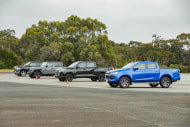
What space cab / extra cab / king cab ute models are still on sale?
There’s a pleasant middle-ground in the ute market that only appeals to a few buyers out there - the space-cab or extra-cab or king-cab model.
There’s a pleasant middle ground in the ute market that only appeals to a few buyers out there - the space-cab or extra-cab or king-cab model.
These vehicles were once offered for those who didn’t need full-time rear seat accommodation and needed a bit more space than a dual-cab ute offered them for their tools.

These days, this extra-cab style body is rare, but there are still a few versions around. Just note - most of them don’t actually have seats in the back anymore, despite having clever B-pillar-less designs with those so-called “suicide” rearward opening doors to gain access to the second row, were there to be one.
Nope, it seems brands have removed the jump seats in favour of a big old storage spot, which is actually great for keeping your tools secure or anything else of value off the back of your truck. Also, your dog will like it more there than they will on the back if the weather isn’t great.
Seriously though, it is this writer’s understanding that part of the reason those rear seats have been removed is due to safety expectations. So if you need more than two seats, I’d suggest a dual-cab is a better option.
How much more space in the tray do you get? In cab-chassis models, that’ll depend on the tray fitted, but the typical increase is at least a foot (300mm) in length for the tray.

For instance, a Triton Club Cab pick-up has an 1850mm tub length, while the dual-cab length is 1520mm. In the back of a Nissan Navara, the tub is 1851mm for a King Cab, and 1509mm for a Dual Cab.
Here’s a list of each of the remaining cab-chassis utes, the variants available, and how many seats they have:
4x2:
- Ford Ranger Super Cab (2.0-litre turbo-diesel) 4x2 - XL cab-chassis, six-speed auto. Four seats.
- Isuzu D-Max Space Cab (3.0-litre turbo-diesel): 4x2 - SX cab-chassis, six-speed auto. Two seats.
- Mazda BT-50 Freestyle Cab (3.0-litre turbo-diesel): 4x2 - XT cab-chassis, six-speed auto. Two seats.
- Nissan Navara King Cab (2.3-litre twin-turbo-diesel): 4x2 - SL cab-chassis, seven-speed auto. Four seats.
- Toyota HiLux Extra Cab (2.8-litre turbo-diesel): 4x2 - SR pick-up, six-speed auto. Four seats.
4x4:
- Ford Ranger Super Cab (XL - 2.0-litre turbo-diesel; XLT - 2.0-litre twin-turbo-diesel): 4x4 - XL cab-chassis, XL pick-up, XLT pick-up - all with 10-speed auto. Four seats.
- Isuzu D-Max Space Cab (3.0-litre turbo-diesel): 4x4 - SX cab-chassis, LS-U pick-up - all with six-speed auto. Two seats.
- Mazda BT-50 Freestyle Cab (3.0-litre turbo-diesel): 4x4 - XT cab-chassis. Two seats.
- Mitsubishi Triton Club Cab (2.4-litre turbo-diesel): 4x4 - GLX cab-chassis six-speed manual or six-speed automatic, GLX+ pick-up six-speed auto. Four seats.
- Nissan Navara King Cab (2.3-litre twin-turbo-diesel): 4x4 - SL cab-chassis, SL pick-up, ST-X pick-up - all with seven-speed auto. Four seats.
- Toyota HiLux Extra Cab (2.8-litre turbo-diesel): 4x4 - SR cab-chassis, six-speed manual or six-speed auto; SR5 pick-up, six-speed auto. Four seats.
Buyers should note that if you choose a manual model, in some instances you will miss out on safety technology and equipment. In the Triton, for example, choose auto over manual in the 4x4 GLX will net you the addition of Forward Collision Mitigation (FCM) With Pedestrian Detection, Lane Departure Warning (LDW), Dusk Sensing Headlights and Rain Sensing Wipers.
Further, the HiLux Extra Cab doesn’t come with blind-spot monitoring or rear cross-traffic alert, which is offered on Double Cab HiLux models.

More Tradie Ute Guide


